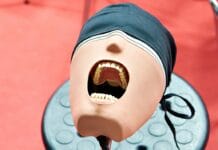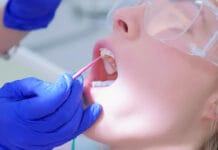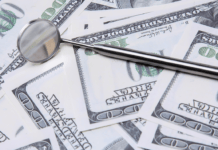For some dental hygiene students, their last semester is fast approaching which means preparing for board exams and applying for your dental hygienist state licensure. One of the many board exams a dental hygiene student must take is the national dental hygiene board exam (NBDHE). The NBDHE definitely can be very intimidating. It’s one of the many steps and requirements for licensure and becoming a dental hygienist. I bet you still can vividly remember when and where you took your exam; in a room with a number two pencil or at a test center on a computer. Do you remember how you felt before the exam date and after you finished?
The Joint Commission on National Dental Examinations (JCNDE) is the organization which creates and administers the National Board Dental Examinations (NBDE), which includes our national board, NBDHE. According to the latest NBDHE 2019 Guide, the reasoning behind the exam is to “assess the ability to understand important information from basic biomedical, dental and dental hygiene sciences, and the ability to apply such information in a problem-solving context.” 1
The exam is broken down into two parts with many subsections. Part one involves 200 multiple choice questions focusing on: (1) Scientific Basis for Dental Hygiene Practice, (2) Provision of Clinical Dental Hygiene Services, and (3) Community Health/Research Principles. Some common topics found on the exam are radiography techniques/errors, head and neck anatomy, planning and managing dental hygiene care, the stages of periodontal disease, oral pathology, and pharmacology. Part two is 12-15 patient cases and scenarios, which includes 150 multiple choice questions. In each patient case, a medical history, dental chart, periodontal charting, intraoral photos, and radiographs are given to refer to when answering the exam questions.2
For those dental hygiene students that will soon experience the NBDHE first hand, I have collected a few methods, thoughts, and suggestions to aid you while studying and help you to achieve overall success:
Organize your time and make a studying schedule
In dental hygiene school, I knew I wanted to take the NBDHE before graduation. I took it in March of my last year of the two-year program. Some hygiene programs have the whole class take the exam all at once around March (this was the case for many RDH years ago). What I’m saying is, if you have the choice to decide when to take the exam, know yourself, and make the decision for yourself (whether that be taking it early or after graduation). I would recommend if you decide to take it after graduation, do not take too long. After graduation, it is a time to celebrate, relax, apply for your license, and start your career. This is why I took it early. I wanted to get it done early, so I could take some stress off myself and enjoy the rest of the semester.
Whatever your decision is, plan when you will study and how often. At this point, you should have some idea of what your studying skills are and what works for you. Are you that type of learner that can read material, immediately absorb it, and can continue on? Or are you a person who must read material a few times to fully grasp the information? Ask yourself: how fast can you absorb the material and how long does it usually take?
I’m the type of learner that needs to study the same material a few times to feel confident about and fully absorb it. With that said, you must figure out your test date and go from there. Once you have a date, you can organize your schedule, and plan when your study time will be. In my case, my test was in March, so after my third semester and the holidays were over, I started to study. I did something each day to study. Will you study for a few hours per day or on certain days throughout the week?
There might be bumps along the way in your studying or your journey to the exam. I live in New England and weather is unpredictable, even in March. I planned to take my exam during spring break (what a nice way to spend my week off right?). So of course with my luck, there was a huge blizzard during that week. I had no clue what was going to happen. I called my testing facility multiple times, and the day before my exam they canceled it. I had to find another place to take this test. I was on the phone for hours with the customer service of the NBDHE because I was determined to get the exam done that week. Eventually, I got the exam scheduled for later that week. (It’s also important to mention that I had to switch my testing facility to one that was in a major city an hour away with still a lot of snow on the ground.) I am grateful for my parents who offered to drive me because they knew how crazy nervous and stressed I was going to be before and after the exam.
Understand and know how the NDHBE is run: all the rules, requirements, and the breakdown of the questions
Each year, the NDHBE posts the breakdown of the questions based on each topic. The NBDHE posts an updated candidate guide, with all the rules, requirements, steps to apply for the exam, and gives how many of questions each topic will have on the exam. Each candidate has up to 9 hours to complete the exam.
In the candidate guide, they include sample questions to represent each question structure that you will see on the exam. On the exam, students will see ” complete the questions” (where you finish the statement with the best answer), True-False (there will be two statements in each answer option, you must decide which letter choice is correct), standard multiple choice, negatives (which use the words “except” or “not”, you must choose the answers not associated with what is being asked), and testlets (multiple questions will be asked on a specific topic with background information or scenario given).
One important note about the NBDHE is there are questions which will be thrown out if a certain amount of candidates incorrectly get a question wrong within the testing window. In recent years, a numerical score is not reported to the candidates. Candidates will only see the word “pass.” To receive a pass, a candidate must achieve a 75 or higher score.
Collect study materials and resources
When first starting out, collect your class notes and PowerPoint from each course. Open your textbooks and bookmark key topics and concepts. You can make your own study guides too.
I recommend using different study materials and resources to achieve a better understanding because sometimes material can be written or asked different ways, which can be beneficial when preparing for the exam. The NBDHE sometimes posts previous exams for you to have an idea about their question structure. There are also board exam workbooks that breakdown the questions the same way as the actual exam.
Know your strengths and weakness
What subjects are your more proficient in? Is it head and neck anatomy or pharmacology? Focus on information that you don’t know. This helps you become more well rounded prior to the exam. But remember to review the material you know well once in a while too. You must find a balance in the information.
Books, apps, and seminars
Some other options to help you study are using national board exam books that break down the test with a lot of different questions similar to questions on the exam. There are also a few apps that you can download (some are free and some you can buy). I used an online resource I signed up for that contained extremely hard questions, which then made the national board questions seem easier in comparison. You can also ask your professors to do a review on certain topics or ask them to share their PowerPoints as a reference.
Another alternative is attending a board review seminar. Some seminars are all day long while others are a few days long. Some seminars travel all over the country, while some are other dental hygiene programs hosting. Usually, the seminar will provide you with some educational materials or notes for you. I traveled with a few of my classmates to another state to attend a 3- day seminar. They gave us a huge seminar book with all the presenters’ PowerPoints and notes, which was extremely helpful. Seminars are also nice to do a little networking and talking about your experiences with other soon-to-be RDHs too. In some seminars, you can buy some cute RDH merchandise too, which makes it a little fun.
On the test, you may notice exact or similar questions from your study materials. I’m warning you now, don’t just memorize the question and answer; understand the actual material so you can use critical thinking to answer questions. I remember on my exam, I had questions that I had to think of what I knew and applied it to the question.
I’m not saying you need to attend a seminar or buy an app to pass. These are just alternatives that can aid as possible options. I had classmates who studied two weeks before with their notes and passed. For me personally, I needed a variety of studying resources to feel confident. I used the seminar as a way to test myself to see what I knew already, and I learned what I still needed more time to study.
Take all the allowed breaks throughout the exam (if you want)
Throughout the test, once you have completed a part or section of the exam, your computer will give you the option to have scheduled break. This is an opportunity to have a light snack, drink some water, get up, walk around and stretch your legs, and this is your chance for a bathroom break. I took all my breaks just to refresh and compose myself for the upcoming section. These are optional breaks, so if you want to get the exam over with, go for it!
Don’t focus or stay on a question for too long
Try not to stay on one question for too long; remember it is timed! You can always go back later. When taking the exam on a testing center computer, you are allowed a whiteboard (or paper) that is given to you so you can write whatever you want on there. You can flag questions to remind you to go back to that specific questions. Another tip is don’t over flag either. That’s what I did, and it can make you second guess yourself.
Once you’re done, you’re done, distract yourself afterward
One thing I used to make myself feel better before, during, and after the exam was knowing that some questions were going to be thrown out if enough students got it incorrect. This allowed me to not focus on one question for a long period of time. I said to myself, if I didn’t know the question, there were others who possibly didn’t either.
I made myself sick afterward because I kept going over the exam and all the different questions in my head (especially if you took the exam around the same time as your friends or classmates). Try to distract yourself afterward if you can. My parents brought me to Olive Garden after my exam, and I struggled to eat. If you know me this is usually never an issue. I love eating and Olive Garden! I also had a hard time going to sleep too. It was torturous for days.
Perhaps, make an agreement with your classmates and friends not to discuss the test afterward or find something to stay relaxed. Do something you really like to do! Go have a spa day – because YOU deserve it, especially after a nine-hour test!
A few weeks later you will receive your results. Seeing the word “PASS” can bring tears to your eyes and a smile to your face because it is such a weight off your shoulders. It will be one step closer to getting the RDH after your name. If it wasn’t your day, that’s ok too. Please, please, please remember that no exam can or will define you as a hygienist or your success in the field. Everyone sometimes fails in life. Yes, it is a setback. Yes, it’s devastating; but you WILL take the exam again, and you WILL pass. This exam can break you down and make you question your knowledge of all the corners of the profession, but once it’s over, it’s over. You can feel the new confidence after passing the exam. You got through it, and it made you better as a future hygienist.
Best of luck to all the soon-to-be graduates! Relax, breath, and be confident; you got this!
Before you leave, check out the Today’s RDH self-study CE courses. All courses are peer-reviewed and non-sponsored to focus solely on pure education. Click here now.
Listen to the Today’s RDH Dental Hygiene Podcast Below:
SEE ALSO: 5 Tips for Passing the National Board Dental Hygiene Examination
References
- Joint Commission on National Dental Examinations. (n.d.). About the JCNDE. Retrieved from https://www.ada.org/en/jcnde/about-us
- Joint Commission on National Dental Examinations. (n.d.). National Board Dental Hygiene Examination (NBDHE) 2019 Candidate Guide. Retrieved from https://www.ada.org/~/media/JCNDE/pdfs/2019_NBDHE_Guide.pdf?la=en











